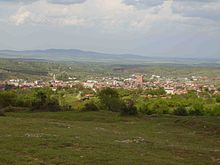Topolowgrad
| Topolovgrad (Тополовград) | |||
|
|||
| Basic data | |||
|---|---|---|---|
| State : |
|
||
| Oblast : | Haskovo | ||
| Residents : | 4986 (December 31, 2016) | ||
| Coordinates : | 42 ° 5 ' N , 26 ° 20' E | ||
| Height : | 311 m | ||
| Postal code : | 6560 | ||
| Telephone code : | (+359) 0470 | ||
| License plate : | X | ||
Topolowgrad ( Bulgarian Тополовград , city of poplars , Turkish Kavaklı, Greek Καβακλί) is a city with 4986 inhabitants (2016) in the Bulgarian Oblast of Chaskovo on the north side of the Sakar Mountains and at the same time the administrative seat of the municipality of the same name.
Topolowgrad is on the 2nd order II / 76 national road , which connects the city with Charmanli in the west and Elchowo in the northeast.
geography
Topolowgrad lies on the northern slopes of the Sakar Mountains in its transition to the Manastir hills . The Bulgarian-Turkish border runs nearby, with the closest border crossings being at Swilengrad ( Kapitan Andreewo-Kapıkule border crossing ) and Lessowo ( Lessowo-Hamzabeyli border crossing ). The next larger town is Elchowo. The provincial capital Chaskovo is about 90 km to the west and Jambol , 55 km to the northeast.
The 3rd order national road III / 559 also runs through Topolowgrad .
Topolowgrad is not connected to the Bulgarian rail network. The nearest train stations are in Yambol and Simeonovgrad .
Topolovgrad municipality
The city council also functions as the local council and is responsible for overseeing all mayors of the localities. The following villages also belong to the municipality of Topolowgrad (Bulgarian Община Тополовград / Obschtina Topolowgrad):
history
Ottoman and New Bulgarian Period
On a tax list ( Defter ) at the time of the Ottoman Empire 1492/93, 33 Muslim families are registered in "Kavakli". At the beginning of the 17th century, 104 Christian families are recorded. In the middle of the 19th century, the area was pacified and an intensive influx of Christian populations began. Gradually the city developed into a handicraft and trade center, also known for its viticulture. In January 1878 the city was liberated in the Russo-Ottoman War of 1877/78 by advancing Russian troops and in the summer of the same year, after the Treaty of Berlin , it became part of the autonomous province of Eastern Rumelia and became the center of the Sliven district . Even before and especially after the withdrawal of the Turks, after the unification of Bulgaria in 1885, tensions between the majority of the Greek population and the Bulgarians intensified. Kavakli (Greek Καβακλί; today Topolowgrad) became one of the bastions of Hellenism in Bulgaria.
From 1906 the gradual displacement of the city's Greek population began, especially in 1911 - on the eve of the Balkan War of 1912/13. After the Second Balkan War (1913), the city had taken in many Macedonian and Thracian refugees. After the First World War in 1919 and the signing of the agreement between Mollow and Kaphantaris , the Mollow-Kaphantaris Agreement (1923), the national composition changed completely - all Greeks emigrated and Bulgarian refugees, mainly from western and eastern Thrace, took their place , as well as dozens of families from the Aegean region and Macedonia .
For a time camel breeding was a major occupation. This was brought there by the refugees from Asia Minor. By resolution of August 30, 1934, Kavakli was renamed Topolowgrad and the city was added to the Burgas Province together with the Elchowo district . In the years following the arrival of the Bulgarian refugees from Thrace and Macedonia, tobacco cultivation increased in the area; many families worked in agriculture and viticulture. A city park was created in 1935, and street lamps were put up in 1936. In 1938 the construction of new schools and the court began, in 1939 the financial administration was added. At that time there were three churches in the city, in 1936 the new church of the Virgin Mary was completed. In the winter of 1939 Topolowgrad was from Tsar Boris III. visited.
1944 until today
After September 9, 1944, a large rally was held in Topolovgrad in honor of the Soviet military unit of Colonel Alexander Sergienko. In May 1945 Topolowgrad became the center of a district again. In the early 1950s a building boom began with a series of public works - in 1952 a hospital was built, a new “Stalin” library was renamed in 1954 as the “ Dimitar Blagoew Library”. On May 18, 1964, the city was visited by Todor Zhivkov .
In the 1960s, attempts to seduce Roma began, whose houses were built on the lower edge of the city and in the hamlet of St. Elias. Mass emigration from the region and the city began in the 1970s, and particularly in the 1980s. The boys in particular moved to larger cities such as Stara Sagora , Yambol , Plovdiv , and Haskovo . This process continues to this day.
sons and daughters of the town
- Peter Mim (* 1952 as Peter Stefanow Todorow), pantomime


